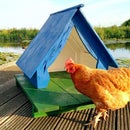Introduction: Several Methods to Use Cement to Make Concrete Chickens
If Instructables would not exist, I probably never would have tried to make anything from cement. But when I saw the concrete and cement contest I wanted to try what I could do with cement. I enjoyed it so much that I extended my project, so I could try several methods of making something from cement:
- Making a chicken from a wire mesh covered with cement.
- Making a nest with some eggs.
- Making a bowl with the structures of a leaf.
- Making a wall decoration.
- Making hands with gloves.
- Painting the cement
I will describe all these methods in the next steps.
As theme I chose a chicken, because we have a chicken and she likes to hang out next to a large window of our house. That area could use some decoration and cement is a suitable material to use outside.
Step 1: Which Cement to Use?
There are many types of cement available in the shops and originally I did not know which type to use. I found out that there are rapid setting cements, but I was afraid that would not give me enough time to make what I had in mind, so I decided I would not use that. There are also a lot of premixed types of cement where sand is already added. Since I did not yet know what the best mixing ratio of cement and sand would be for the different methods, I decided to buy just ordinary Portland cement and sand, so I could mix it myself. That is also the cheapest option.
Safety remark:
The instructions on the cement bag say that we have to wear gloves. I did not immediately do that, but the cement made the skin of my hands very dry. With a longer exposure the chemicals in the cement could have burned my skin, so from experience I can now say that it is much better to protect your hands by wearing gloves.
I also recommend to wear a respirator or nose mask when handling the dry cement because a lot of fine dust is coming from the cement.
Step 2: Starting Easy by Making Hands From Gloves
I have seen several projects where somebody filled a glove with cement to make concrete hands. That seemed quite easy so I decided to start with that.
I mixed the cement with sand in a ratio of 1 part cement and 4 parts of sand. It worked, but next time I would prefer to use 1 part of cement and 3 parts of sand, because the 1:4 ratio gives a mixture that seems to be quite loose when it is not yet set.
It is best to mix the sand and cement when both are still dry and then add some water. It should not be really wet, so add a little bit of water at a time and mix carefully in between. When the mixture is ready, it is just a matter of filling the gloves. After that I placed the gloves in a bowl so the hands would come out with the fingers slightly bent.
After a few hours I cut the gloves partly open, but next time I will not do that. The water does not have to evaporate from the cement as it chemically reacts with the cement mixture, so it only needs some time to cure. I think it would be best to remove the gloves after two days, but I was impatient and removed the gloves after one day and that also worked well.
The only thing that was a bit difficult was removing the gloves from between the fingers. Next time I will make sure the fingers do not really touch eachother while the cement is curing, so the gloves can be removed more easily afterwards.
Step 3: Make a Wooden Frame to Contain the Cement
I wanted to make a concret decoration on the wall, but I also wanted it to be removable from the wall if I would not like the result. So I decided to make a wooden frame to contain the cement. I hammered some nails in the wood and used steel wire to make a mesh between the nails. This makes sure the concrete stays attached to the wood and it makes it less likely that the concrete will break, because my layer of cement is less than 1 inch thick.
I used some tape to make sure the cement would not drip out of the little gaps in the wood. I doubt if that really would have happened, but better safe than sorry.
Step 4: Filling the Wooden Frame With Cement and Decorate the Cement
Since I did not like the 1:4 mixing ratio that I used for the cement in the gloves, I now use a mixing ratio of 1 part of cement and 3 parts of sand and I was happy with that. I placed the hands on a point where it would like they were feeding the chicken and filled the rest of the frame with cement. Then I made the cement flat at the bottom part of my frame and I used a piece of would as a template to draw some lines in the cement to make it look like brickwork.
Above the hands I just worked with the cement as if it was clay and formed some chickens and a hen house. Then I left it to dry for 2 days.
Step 5: Painting the Cement
It was possible to see the chickens when all the concrete was just gray, but I wanted to make them also visible from a further distance. We had some gray paint special for concrete left over from concrete we painted several years ago. I first used that as a base layer so the white paint could be used over that. The white paint was just regular paint suitable for wood, but it worked fine here. In one of the next steps (on the eggs) I used the same white paint without the base layer of special paint for concrete and I did not notice much difference. I think that for decoration only it does not matter a lot if you use a paint special for concrete or not. But if you paint a concrete floor where many people will walk, then the special paint for concrete will probably last much longer.
Step 6: Make a Bowl to Feed the Chicken and Use Leafs
I saw people use leafs and cement on some other projects, so I also tried this. I did not have very large leafs, so I used several smaller ones. I first made a pile of sand, which would be the inside of the bowl. Then I placed six leafs over it. Next time I will do that different. It would be better to place the bottom side of the leafs up so the concrete would get the texture from that side as usually there is more structure on the bottom side of the leafs. Also it was not ideal to have all the ends of the leafs in the centre of the bowl, because they made a gap in the concrete there.
I again used a 1:3 mixture of cement and sand and put that over the leafs. It is not so easy to see if the cement has the same thickness everywhere, so that was a bit of a gamble, but it came out OK. I used some loose sand to support the cement while I made a flat top and later that would be the flat bottom of the bowl. I left the sand there and only removed it after a day when the cement had cured.
Step 7: Make a Nest and Eggs
In the night before I made the nest, we had a storm and the wind blew an old abandoned next out of a tree. I collected the materials the birds had gathered and tried to make a nest on a piece of wood. The birds make it look easy to make a nest and they do not even use cement, but I found it a bit difficult. When the cement is too dry the little branches do not really stick together. And when the cement is too wet, it becomes one large pile of cement and you do not see the little branches anymore. But with some trial and error I got something that looks like a nest.
I had some remaining wet cement and shaped that like an egg and used some sand to support the eggs while the cement cured.
Step 8: Make a Pole for the Chicken to Sit On
In general chickens like to sit on an elevated pole, so I made one from wood. To add cement I soaked some rope in water and then in very wet cement and wrapped the rope around the pole. The rope does not add a lot and soaking rope in cement is also not something I would do again. With too little cement or too wet cement it does not stick to the rope, but with too much cement, you do not see the rope anymore.
But for now I have a pole for the chicken to sit on.
Step 9: Making a Frame for the Concrete Chicken
I thought that it would be quite difficult to make a concrete chicken, but it was much easier than I expected. I used some wire mesh and made a cilinder from that. I planned to use some steel wire, but that was not needed. The wire mesh can get the shape of a chicken by pushing some parts inwards. If you pushed it inwards too far, just use a screw driver and use it to pull back that part.
Step 10: Make a Base Layer for the Concrete Chicken
I soaked some old cloth in very wet cement (only cement and water, so no sand) and wrapped the cloth around the wire mesh. Immediately after that I mixed some cement in a ratio of one part cement and three parts of sand and made a layer of about 1/4 inch over the cloth. Then I left it to cure for about 5 hours so it would be quite firm already.
Step 11: Making the Final Layer for the Concrete Chicken
I needed a model for the concrete chicken, so I waited until our chicken sat down in front of the window and took a photo. Then I had that photo visible on my tablet while I made the final layer of the chicken. I did that about 5 hours after the first layer. Now I used a mixing ratio of one part cement and only 1.5 part sand. Than the mix is more like a clay and sticks very well. I made small thin parts and just rubbed them on the chicken. Then I used a small spoon and a small knife to carve some structure in the chicken. I am quite happy with the result.
Step 12: Installing Everything Outside
I took all parts that I made and placed them outside in front of our window.
Step 13: Check by Our Chicken
Our chicken checked my work and she seems happy with it. Or is she only interested in the food?







